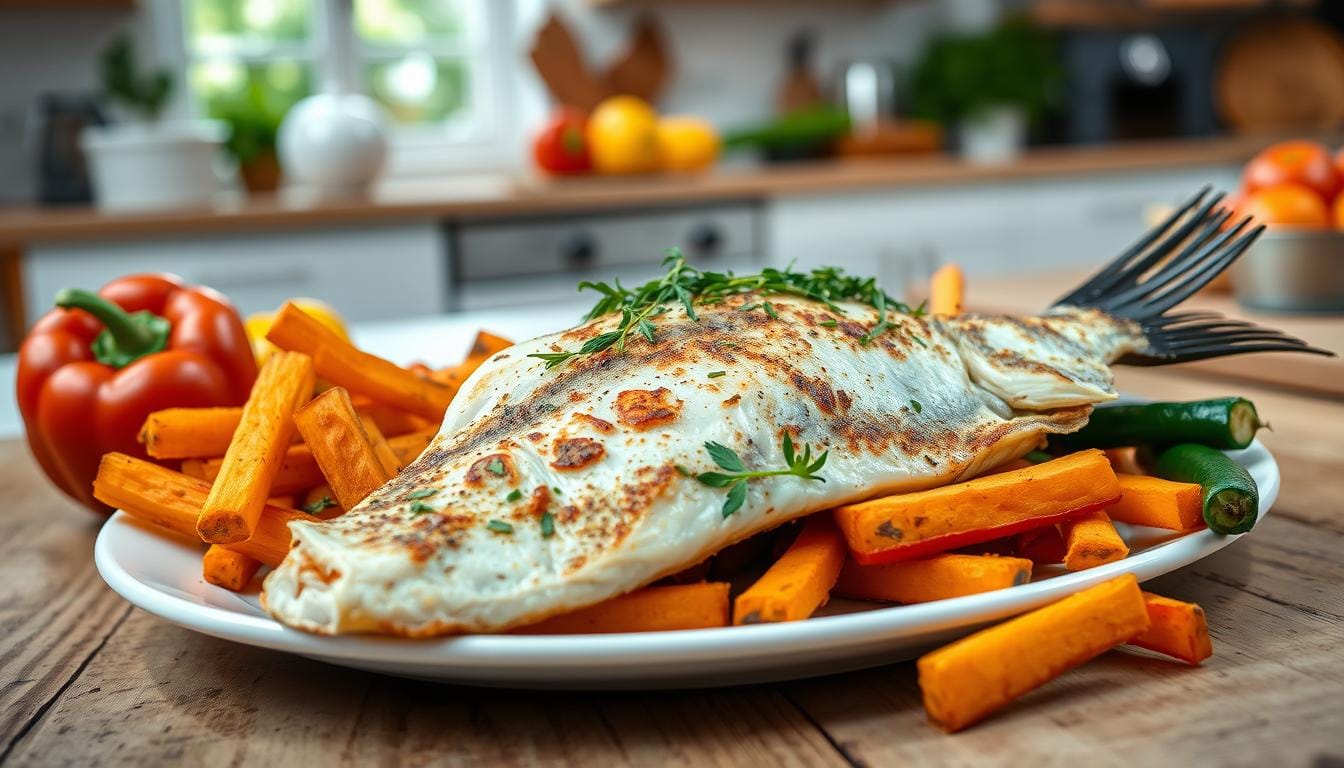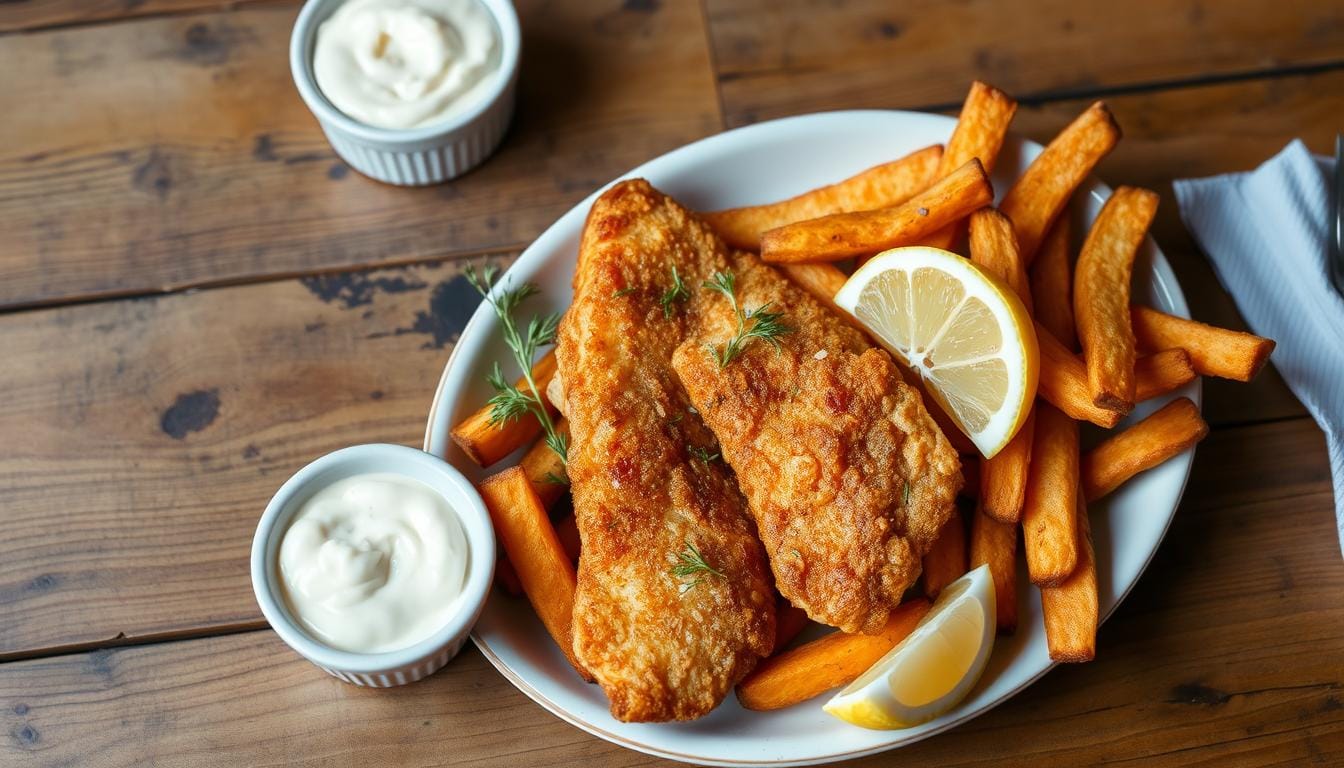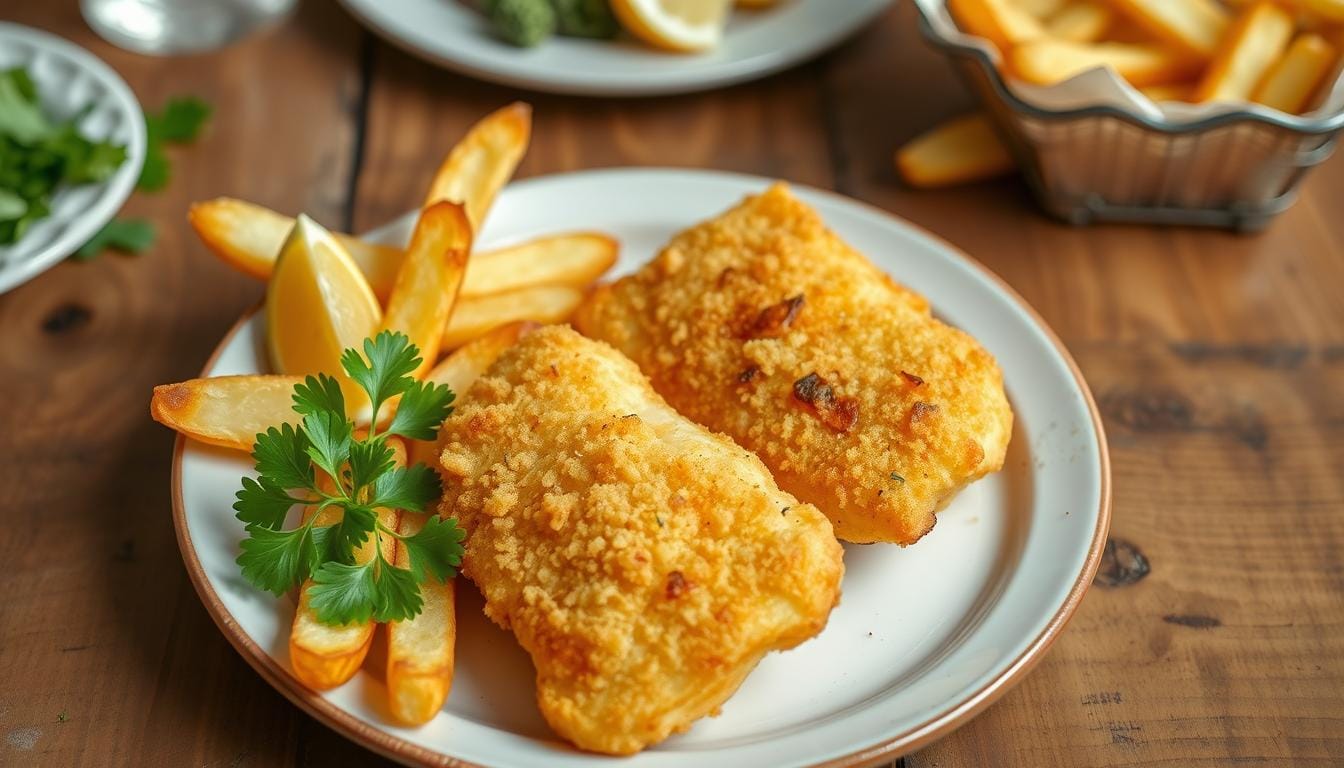Lectin-Free Fish and Chips is the perfect way to enjoy a classic dish without the inflammation caused by lectins. Finding lectin-free fish and chips that are both tasty and healthy is easier than you think! Today, I’m thrilled to share a recipe that lets you indulge in the classic flavors of fish and chips.
Fish and chips have always been a big part of my family’s traditions. The crispy batter, tender fish, and crunchy fries were always a hit. But when I learned about the effects of lectins, I knew I needed a healthier alternative.
After countless kitchen experiments, I finally created a lectin-free fish and chips recipe that’s just as delicious as the original. Using special flours, healthier oils, and the right potatoes, this version is perfect for anyone on a lectin-free diet or simply looking for a guilt-free indulgence.
If you’re ready to explore the world of lectin-free cooking, this recipe is a great place to start. Together, we’ll make fish and chips that’s not only good for you but also packed with amazing flavor!
Table of Contents
Introduction to Lectin-Free Cooking
Exploring lectin-free cuisine opens up new culinary possibilities. Lectins are proteins in many plant-based foods, like legumes and grains. They can cause digestive issues and affect nutrient absorption in some people.
What are Lectins?
Lectins are proteins that bind to the gut lining, causing irritation. This can lead to conditions like leaky gut syndrome and chronic inflammation. A lectin-free diet may help those with autoimmune disorders or sensitive stomachs.
Why Go Lectin-Free?
A lectin-free lifestyle is great for those who prefer plant-based seafood, anti-inflammatory cooking, or nightshade-free cuisine. It can reduce gut discomfort and improve nutrient absorption. It may also lower systemic inflammation.
Benefits of Lectin-Free Diet
- Improved gut health and reduced digestive issues
- Decreased inflammation throughout the body
- Enhanced nutrient absorption and overall well-being
- Potential relief for those with autoimmune or chronic health conditions
- Expanded culinary options with a focus on lectin-free ingredients
Adopting a lectin-free diet can be life-changing. It lets you discover new flavors and health benefits. By understanding lectins, you can make choices that nourish your body and enjoy a healthier lifestyle.

Ingredients for Fish and Chips
Making delicious lectin-free fish and chips starts with picking the right ingredients. For the fish, go for mild, white types like cod, haddock, halibut, or pollock. These fish have a delicate taste and less lectins.
Fresh Fish Options
- Cod fillets
- Haddock fillets
- Halibut steaks
- Pollock fillets
Alternative Coating Ingredients
To get a crispy, golden crust without wheat flour, try lectin-free options. Use cassava flour, almond flour, or arrowroot powder. They make a gluten-free batter and add a special texture and taste.
Traditional vs. Lectin-Free Ingredients
| Ingredient | Traditional | Lectin-Free |
|---|---|---|
| Flour | Wheat flour | Cassava flour, almond flour, arrowroot powder |
| Oil | Vegetable oil, canola oil | Avocado oil, refined olive oil, coconut oil |
| Potatoes | Russet potatoes | Sweet potatoes |
By swapping these ingredients, you can enjoy fish and chips without the lectins. It’s a simple way to make your diet healthier.

Preparing the Fish Fillets
When preparing your fish fry, start with the best ingredients. Look for fresh fish with bright eyes and firm flesh. If using frozen, thaw it well before cooking.
Cleaning and Filleting the Fish
First, pat the fish dry with paper towels. This helps the anti-inflammatory cooking batter stick better. Then, cut the fish into 4-5 inch pieces for even cooking.
Marinating for Flavor
Marinate the fish in lemon zest, garlic, and herbs for flavor. Let it sit for 30 minutes to 2 hours. This lets the flavors soak into the fish.
Perfecting the Texture
After marinating, pat the fish dry again. Don’t remove the marinade. Season with salt and pepper to bring out the healthy fish fry flavors.
“The key to a delicious and crispy fish fry lies in the preparation of the fillets. By starting with the highest quality ingredients and carefully prepping the fish, you’ll set yourself up for success in the kitchen.”
Making the Batter
Making the perfect gluten-free batter is key for crispy lectin free fish and chips. You can get a light, airy texture without using wheat. This keeps the flavor and nutrition high.
Choosing the Right Alternatives
For a lectin-free batter, mix cassava flour, arrowroot powder, baking soda, sea salt, and black pepper. Cassava flour is strong, and arrowroot powder adds crunch. Baking soda makes it light and airy.
Step-by-Step Batter Preparation
- In a medium bowl, whisk together cassava flour, arrowroot powder, baking soda, sea salt, and black pepper until well mixed.
- Pour in sparkling water slowly, whisking constantly. This makes the batter smooth and pourable. The carbonation helps with crispiness.
- Let the batter rest for 5-10 minutes. This lets the ingredients mix fully before coating the fish.
Tips for a Crispy Finish
- Make sure the batter fully covers the fish for even crispiness.
- Keep the batter thin by adding more sparkling water as needed.
- For extra crunch, dust the coated fish with cassava flour or arrowroot powder before frying.
By following these steps, you’ll enjoy a crispy, lectin-free fish and chips dish. It’s just as good as traditional recipes. Bon appétit!
Cooking Methods
Choosing the right cooking method is key for a healthy fish fry. Deep-frying can be tasty but isn’t always the healthiest choice. Luckily, there are other ways to cook fish that are both delicious and anti-inflammatory without extra oil.
Deep Frying vs. Air Frying
Deep frying in avocado or sunflower oil can make your fish crispy. Heat the oil to 350°F to 375°F (175°C to 190°C). Fry the fish for 3 to 4 minutes on each side until it’s golden.
For a healthier option, try air frying. This method uses hot air to cook the fish, making it crispy with almost no oil. Set your air fryer to 400°F (204°C). Cook the fish for about 10 minutes on each side, until it’s 145°F (63°C) inside.
Baking Fish for a Healthier Option
Baking is a great way to enjoy a healthy fish fry without oil. Preheat your oven to 400°F (204°C). Bake the fish for 10 to 12 minutes, flipping it halfway. It should flake easily with a fork and be 145°F (63°C) inside.
Tips for Perfect Cooking Temperature
No matter how you cook, keeping the temperature right is essential. Use a food thermometer to check the fish’s internal temperature. Adjust the cooking time or temperature as needed for the best result.
Making the Chips
Creating the perfect lectin-free fish and chips starts with the right potato. Instead of white potatoes, use sweet potatoes. They’re not only a tasty twist on the classic but also packed with nutrients.
Selecting the Perfect Potatoes
Look for sweet potatoes that are firm and have no blemishes. Avoid any with green spots or wrinkles. These can mean they have harmful lectins. Try different types, like orange or purple, to find your favorite.
Cutting Techniques for Chips
- Peel the sweet potatoes to remove the skin.
- Cut the peeled potatoes into long, thin strips, resembling traditional french fry shapes.
- Soak the cut potato strips in cold water for at least 30 minutes to help remove any excess starch. This step will ensure your chips achieve a crispy texture during cooking.
- Pat the potato strips dry thoroughly with paper towels or a clean kitchen towel before cooking.
Flavoring Options for Chips
Once your sweet potato chips are prepped, try different seasonings. Mix sea salt, black pepper, garlic powder, or paprika for a kick. Fresh herbs like rosemary or thyme add a nice aroma.
By following these steps, you can make a tasty lectin-free fish and chips. It’s a great option for a healthy, lectin-free diet. Enjoy this nightshade-free dish as part of your balanced lifestyle.
Serving Suggestions
Make your plant-based seafood or healthy fish fry even better with tasty sides and dips. Serve your crispy fish with tangy tartar sauce or a squeeze of lemon. For extra crunch, try jicama fries or zucchini fries.
Balance the fish’s richness with a cucumber tomato salad, arugula salad, or broccoli salad. These fresh sides add vitamins and minerals, enhancing the fish’s flavors.
Plating for Presentation
Keep your plating simple yet eye-catching. Place the golden fish on a plate with lemon wedges and your favorite sauce. This classic setup highlights your cooking skills.
Pairing with Beverages
Choose a refreshing drink to go with your meal. A chilled white wine or citrusy cocktail can boost the flavors. Or, try iced tea or lemonade for a refreshing touch.
By picking the right sides, dips, and drinks, you’ll make your lectin-free fish and chips a memorable meal. It’s a complete, satisfying experience that shows off your healthy cooking.
Storing Leftovers
Enjoying your lectin free fish and chips doesn’t have to end when the meal is over. You can savor the flavors again later with proper storage. Here’s how to make the most of your leftovers:
Proper Storage Tips
- Store the fish and chips in an airtight container in the refrigerator for up to 3 days.
- Make sure the container is sealed tightly to prevent air exposure, which can lead to sogginess or dryness.
- Avoid storing the fish and chips together, as the moisture from the fish can make the chips lose their crispy texture.
Reheating Instructions
When you’re ready to enjoy your leftovers, follow these steps for the best results:
- For the fish, use a microwave at 50% power, covered, to gently reheat and preserve moisture. Avoid high heat, which can make the coating tough.
- To revive the crispy texture of the chips, reheat them uncovered in a 350°F oven for 5-10 minutes, or until they’re hot and crisp.
- You can also use an air fryer to reheat the chips, which will help them regain their crunchy exterior.
By following these storage and reheating tips, your lectin free fish and chips will stay flavorful and enjoyable, even after the initial meal.
Nutritional Breakdown
Our lectin-free fish and chips dish is not only tasty but also packed with nutrients. A serving (1 fillet) has about 447 calories, 38g of protein, 30g of fat, and 6g of carbs. The health benefits come from the special ingredients we use.
Macronutrients in Your Dish
The fish in our recipe is full of omega-3 fatty acids. These are good for your heart and reduce inflammation. The almond flour adds healthy fats and protein, making you feel full.
The sweet potato chips are a good carb source, full of vitamins, minerals, and fiber. This mix of nutrients makes your anti-inflammatory cooking both tasty and healthy.
Health Benefits of Ingredients Used
- The fresh fish is rich in omega-3 fatty acids, which are known to reduce inflammation and support heart health.
- Almond flour is a great source of healthy fats and protein, providing a satisfying and nutrient-dense coating for the fish.
- Sweet potato chips are a nutrient-dense alternative to traditional potato chips, offering fiber, vitamins, and minerals.
Using these healthy fish fry ingredients in your lectin-free fish and chips recipe is a win-win. You get a meal that’s delicious and also good for your body, with lots of essential nutrients.
Substitutions for Allergies
Dining with food allergies can be tough. But, with a few simple swaps, you can enjoy a tasty lectin-free fish and chips meal. You can make this dish work for your dietary needs, whether you’re allergic to eggs, nuts, or seafood.
Common Allergens and Alternatives
If you’re allergic to eggs, try using a flax egg or aquafaba. Aquafaba is the liquid from canned chickpeas. It’s a vegan substitute for egg whites and helps make your plant-based seafood crispy.
For nut allergies, swap almond flour for coconut flour or another gluten-free batter option. This keeps the crispy texture without the nuts.
Vegan Options for Fish and Chips
- For a vegan version, use hearts of palm or banana blossoms as plant-based seafood. They mimic traditional fish in texture and taste. Coat them in lectin-free batter and fry or bake until crispy.
- Pair your vegan “fish” with homemade oven-baked potato wedges. It’s a healthier twist on the classic dish.
With a bit of creativity and allergy-friendly swaps, you can enjoy a delicious, lectin-free fish and chips meal. Focus on wholesome, nutrient-rich ingredients. This way, you can savor this comfort food classic while boosting your health.
Variations on the Recipe
Make your homemade lectin-free fish and chips even better by trying new flavors. Add dried oregano, onion powder, or paprika to the batter for extra taste. For a richer flavor, use ghee instead of avocado oil.
Global Influences on Fish and Chips
Try adding global flavors to make the dish unique. For an Indian twist, add curry spices like cumin, coriander, and turmeric. Or, go Caribbean with plantains and warm spices like allspice and cinnamon.
Seasonal Ingredients You Can Add
- Add seasonal veggies like zucchini or eggplant to the batter for extra nutrition and texture.
- In summer, mix in fresh herbs like basil or dill into the batter or as a garnish.
- In fall, roast sweet potatoes or butternut squash and mix them into the batter.
- In winter, use root veggies like parsnips or rutabagas for the chips.
Using seasonal produce and global flavors keeps your lectin-free fish and chips recipe exciting. It’s a great way to enjoy anti-inflammatory cooking with endless possibilities.
Conclusion
This lectin-free fish and chips recipe shows that healthy food can be tasty and fulfilling. By swapping out ingredients, you can enjoy favorite dishes while following a lectin-free diet. The interest in food systems like double emulsions has grown by 20.18% in ten years.
Encouraging the Home Cook
Try different ingredients and methods to make your own version of this dish. Double emulsions, especially W1/O/W2, are great for food like fortification and color stability. Use these techniques to make your own tasty, lectin-free fish and chips.
Final Thoughts on Eating Healthy
Eating a balanced diet is important for your health. Just like using the right emulsifiers for double emulsions, a varied diet is key. Enjoy this healthy fish fry recipe and keep exploring lectin-free cooking to feed your body and taste buds.
FAQ
What are the benefits of a lectin-free diet?
What types of fish are best for a lectin-free fish and chips recipe?
How can I make the batter lectin-free?
What are some healthy cooking methods for lectin-free fish and chips?
What are some lectin-free alternatives for the chips?
How can I adapt this recipe for food allergies?
What are some flavor variations I can try with this recipe?
Swalt’s Wisdom:
“Good food is not just what we eat, but what makes us feel happy and healthy.”
Swalt’s Tip:
“Enjoy every bite, and always be mindful of choosing ingredients that boost your health and bring positive energy

